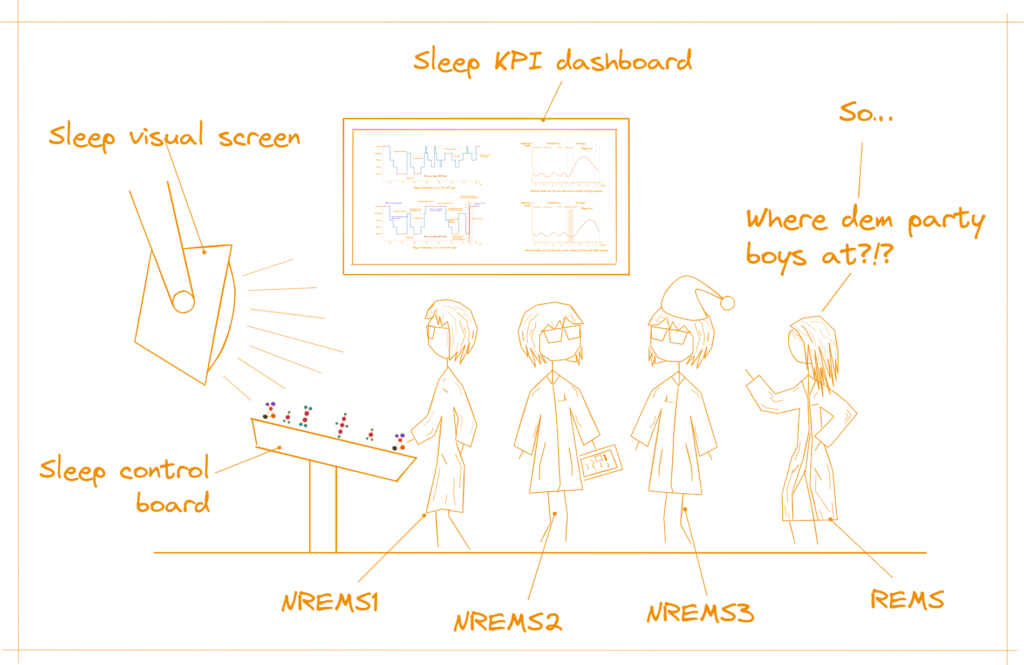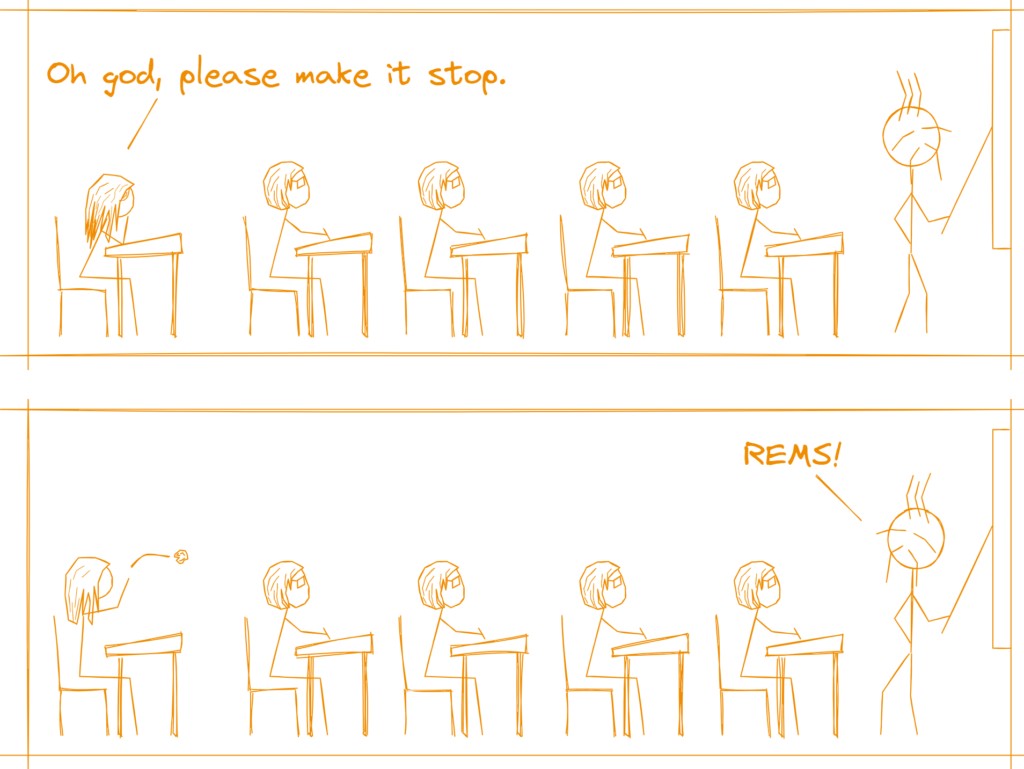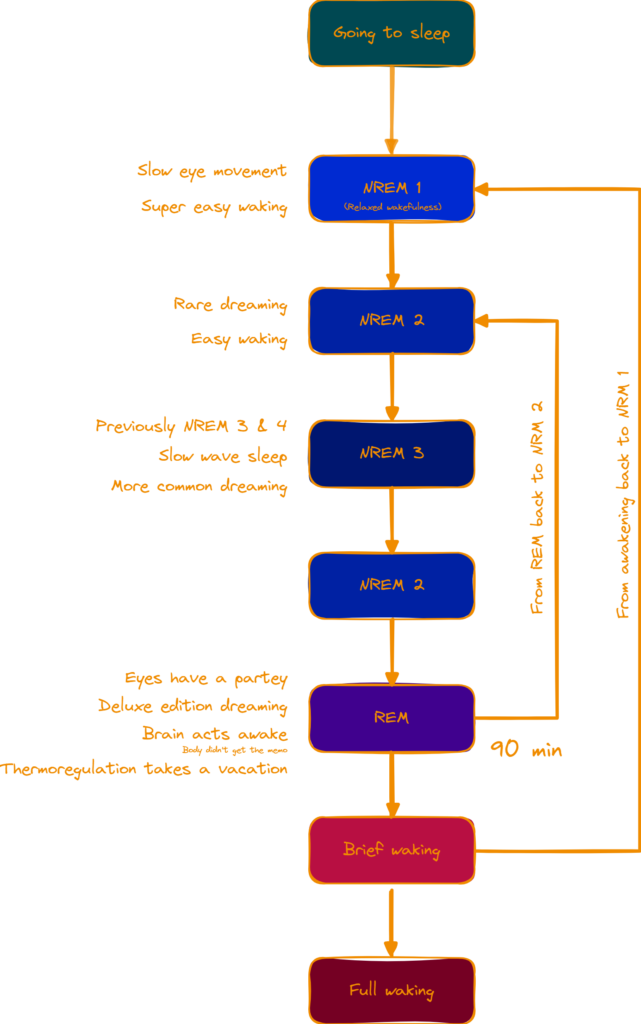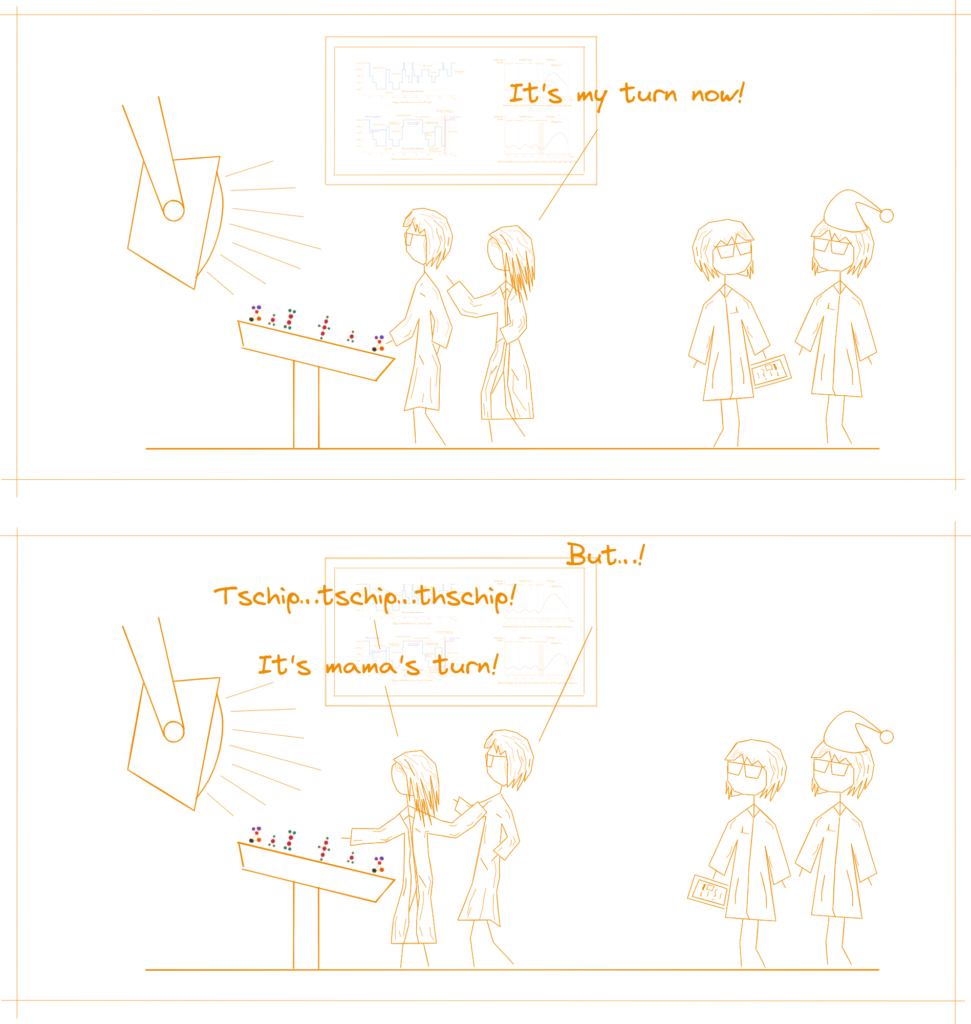Intro
Sleep is a marvel. It repairs the body and recharges it for the next day [Cespuglio 2005, Dzaja 2004, Turek 1999]. But while the we appear to rest, there is a firework of action in the brain that would put the activity of some wakeful state-workers to shame [Eugene 2015, Hobson 2005, Joiner 2016].
In the “Architecture of sleep” we took a look at the phases that govern the human sleep cycle with the strictness of an elementary hall monitor. In this article, we will take a more in depth dive into the exciting world of rapid eye movement sleep (REM sleep or REMS), the party stage of sleeping.

So lean back, turn on your dreams and follow us on this nosy journey into the world of…
REM sleep
The essence of REM
Imagine a computer-station in the human brain. It controls every part of the body from big actions, like moving an arm, to small ones, like changing the secretion of adrenaline.

During sleep, only one sleep-stage is allowed to operate it at a time. Each stage has specific expertise and preferences when it comes to their time at the controls. They target specific sectors and engage different repair mechanisms.
You are describing the setup of Inside Out

Non-rapid-eye-movement sleep (short NREM sleep or NREMS) is a group of calm science workers, that rigorously take care of their station and one after one perform their duty. And then there is REMS, a playful, wild and “not by the rules” kinda gal, who somehow got her degree and became a sleep-stage in the hard school of evolution.

One after one, the sleep-stages take the controls, do the necessary repairs assigned to them before they hand it over to the next stage in line in an orderly fashion.
That is until it is REMS turn. When NREM2 is about to finish, REMS grabs the controls out of her hands and shoo’s her away. In fact the transission from NREM sleep to REM sleep has about the grace of me jumping down the stairs [McCarley 2007].

Under normal conditions REMS does her thing, before she either rouses the body for a short while or hands the controls bag to NREM2.
Only towards the end of sleep does she demand more and more time at the controls until she had enough and gives the go ahead to wake up [Aeschbach 2011, Åkerstedt 2002, McCarley 2007, Peplow 2013, Van Cauter 2000].

Well and good one might say. That is as long as REMS gets enough time at the helm, meaning at least a quarter of total sleep time. If she doesn’t, she will go into whining mode that puts cranky children to shame [Iber 2007, McCarley 2007, Peplow 2013]. And she will continue whining until she gets her allotted time. Not more, because at some point REMS gets bored from pushing all the buttons and hands them over again to one of the NREM-stages [Aeschbach 2011, Ellman 1991, Endo 1998].

Properties of REMS
Regulation of body temperature
While steering the body, REMS loses track of temperature regulation. Perhaps she is too focused on other areas, but if the environment around the body is outside the comfort-thresholds wakefulness will jump in, take control and rouse the body like an overseer that makes sure that the safety margins are met [Parmeggiani 2011].
Paralysis
Another key factor where REMS’ and NREMS’ control of the body differs is how they handle muscles.
While NREMS takes a more laissez-faire approach to muscle control, REMS simply shuts off all motor neurons in humans [Brooks 2012].
There is of course an elementary reason behind this action. If REMS wouldn’t turn off all the unnecessary motors in the body, the poor sleepers would start to move around and act out whatever their internal dream-studios come up with [Lapierre 1992, Steriade 2013].

Eye movement
But does REMS really turn off all motor neurons? No! Some motor neurons, REMS leaves active. For the most part, she keeps those muscles going that are rather important for survival. Sleeping just wouldn’t be the same if humans stopped breathing or pumping blood through their veins. But there are some muscle movements that seem a little out of place.
“Why!?”, many scientists wondered in the past, the present and likely will continue to do so the future. “Why does REMS keeps the eye muscles active”
Some scientists believe that that the eye movement might correspond to a sense of vision during dreaming [Andrillon 2015]. If only humans without the power of sight wouldn’t also dance around with their eyeballs during dreaming that theory would be super dandy [Hobson 2000].
Another theory is that the movement is a side effect of eye-related procedural memory [Zhang 2005, Zhang 2016].
But for now, those are theories and the true reason remains a mystery.
It definitely wouldn’t be below REMS to do the whole eye movement thingy as a joke…ehm…remnant from evolution.
Function of REMS
But REMS is not only fun and games. Behind the party demeanor is a serious worker that impacts both memory and creativity.
Dreaming
When REMS is in charge, she activates distinctive electrical activity in the brain that scientists associate with dreaming [Peplow 2013].
This artist side of REMS is so pronounced that around 80% of dreams only occur during her control [Markov 2012].
Impact on Memory
One reason for the dream stages might be that REMS controls the brain in such a way that it acts as if it was awake. The neurons fire with the same intensity and the energy consumption equals or even exceeds the amounts during wakefulness. The only difference is the mentioned muscle-paralysis that keeps humans in place [Hobson 2005, Matarazzo 2011, Myers 2004].
But why can REMS run so freely in the mind? Why did evolution allow such rampant behavior to succeed and why does the rest of the body not intervene?
One reason might be that REMS proved her worth by reactivating and thereby consolidating newly encoded memories [Walker 2006]. In this way sleep in general is instrumental in moving experiences of the day from short to long term memory.
In the case of REMS this is especially true for procedural (unconscious tasks), spatial (where is what; especially those darnish keys?) and emotional (remembering the true important things) memory [Born 2012, Rasch 2007, Wagner 2004, Zhang 2005, Zhang 2016].
It goes hand in hand with NREMS and especially slow wave sleep (SWS). While REMS looks after the other forms of memory like a mother after her children, SWS concentrates on declarative memory (intentionally remembering stuff) [Born 2012, Fowler 1973, Marshall 2006, Peplow 2013, Plihal 1997, Rasch 2013, Tucker 2006, Yaroush 1971].
Therefore only together REMS and NREMS can fully consolidate memory [Rasch 2013, Siegel 2001].
But despite their joint efforts, NREMS and REMS keep a discance from each other. It goes so far that REMS only activates parts of the brain that NREMS stays away from and the other way around [Hobson 2000].
Impact on creativity
And then there is creativity. The shining ability that humanity so boasts about in front of the other species. Without the keen control of REMS during sleep, creativity would to near zero [Cai 2009, Hasselmo 1999, Rasch 2013, Wagner 2004, Walker 2002].
Outro
Altough REMS might seem wild, unhinged, a maverick even, she is an important part of the sleep-stage-squad.
Sources
| Key | Citation |
|---|---|
| Aeschbach 2011 | Aeschbach, D. (2011). REM-sleep regulation: circadian, homeostatic, and non-REM sleep-dependent determinants. Rapid Eye Movement Sleep: Regulation and Function. Cambridge University Press, Cambridge, 80-88. |
| Åkerstedt 2002 | Åkerstedt, T., Billiard, M., Bonnet, M., Ficca, G., Garma, L., Mariotti, M., … & Schulz, H. (2002). Awakening from sleep. Sleep medicine reviews, 6(4), 267-286. |
| Andrillon 2015 | Andrillon, T., Nir, Y., Cirelli, C., Tononi, G., & Fried, I. (2015). Single-neuron activity and eye movements during human REM sleep and awake vision. Nature communications, 6(1), 7884. |
| Born 2012 | Born, J., & Wilhelm, I. (2012). System consolidation of memory during sleep. Psychological research, 76, 192-203. |
| Brooks 2012 | Brooks, P. L., & Peever, J. H. (2012). Identification of the transmitter and receptor mechanisms responsible for REM sleep paralysis. Journal of Neuroscience, 32(29), 9785-9795. |
| Cai 2009 | Cai, D. J., Mednick, S. A., Harrison, E. M., Kanady, J. C., & Mednick, S. C. (2009). REM, not incubation, improves creativity by priming associative networks. Proceedings of the National Academy of Sciences, 106(25), 10130-10134. |
| Cespuglio 2005 | Cespuglio, R., Colas, D., & Gautier-Sauvigné, S. (2005). Energy processes underlying the sleep–wake cycle. In The Physiologic Nature of Sleep (pp. 3-21). |
| Dzaja 2004 | Dzaja, A., Dalal, M. A., Himmerich, H., Uhr, M., Pollmächer, T., & Schuld, A. (2004). Sleep enhances nocturnal plasma ghrelin levels in healthy subjects. American Journal of Physiology-Endocrinology and Metabolism, 286(6), E963-E967. |
| Ellman 1991 | Ellman, S. J., Spielman, A. J., Luck, D., Steiner, S. S., & Halperin, R. (1991). REM deprivation: A review. |
| Endo 1998 | Endo, T., Roth, C., Landolt, H. P., Werth, E., Aeschbach, D., Achermann, P., & Borbély, A. A. (1998). Selective REM sleep deprivation in humans: effects on sleep and sleep EEG. American Journal of Physiology-Regulatory, Integrative and Comparative Physiology, 274(4), R1186-R1194. |
| Eugene 2015 | Eugene, A. R., & Masiak, J. (2015). The neuroprotective aspects of sleep. MEDtube science, 3(1), 35. |
| Fowler 1973 | Fowler, M. J., Sullivan, M. J., & Ekstrand, B. R. (1973). Sleep and memory. Science, 179(4070), 302-304. |
| Hasselmo 1999 | Hasselmo, M. E. (1999). Neuromodulation: acetylcholine and memory consolidation. Trends in cognitive sciences, 3(9), 351-359. |
| Hobson 2000 | Hobson, J. A., Pace-Schott, E. F., & Stickgold, R. (2000). Dreaming and the brain: toward a cognitive neuroscience of conscious states. Behavioral and brain sciences, 23(6), 793-842. |
| Hobson 2005 | Hobson, J. A. (2005). Sleep is of the brain, by the brain and for the brain. Nature, 437(7063), 1254-1256. |
| Iber 2007 | Iber, C. (2007). The AASM manual for the scoring of sleep and associated events: rules, terminology, and technical specification. (No Title). |
| Joiner 2016 | Joiner, W. J. (2016). Unraveling the evolutionary determinants of sleep. Current biology, 26(20), R1073-R1087. |
| Lapierre 1992 | Lapierre, O., & Montplaisir, J. (1992). Polysomnographic features of REM sleep behavior disorder: development of a scoring method. Neurology, 42(7), 1371-1371. |
| Markov 2012 | Markov, D., Goldman, M., & Doghramji, K. (2012). Normal sleep and circadian rhythms: Neurobiological mechanisms underlying sleep and wakefulness. Sleep Medicine Clinics, 7(3), 417-426. |
| Marshall 2006 | Marshall, L., Helgadóttir, H., Mölle, M., & Born, J. (2006). Boosting slow oscillations during sleep potentiates memory. Nature, 444(7119), 610-613. |
| Matarazzo 2011 | Matarazzo, L., Foret, A., Mascetti, L., Muto, V., Shaffii, A., & Maquet, P. (2011). A systems-level approach to human REM sleep. Rapid Eye Movement Sleep: Regulation and Function, 8, 71. |
| McCarley 2007 | McCarley, R. W. (2007). Neurobiology of REM and NREM sleep. Sleep medicine, 8(4), 302-330. |
| Myers 2004 | Myers, D. G. (2004). Psychology (7th ed.). Worth Publishers. |
| Parmeggiani 2011 | Parmeggiani, P. L. (2011). Systemic homeostasis and poikilostasis in sleep: Is REM sleep a physiological paradox?. World Scientific. |
| Peplow 2013 | Peplow, Mark. (2013, May 22). Structure: The anatomy of sleep. Nature. https://www.nature.com/articles/497S2a#:~:text=In%20a%20typical%20eight-hour%20sleep%2C%20the%20brain%20moves,the%20brain%2C%20and%20is%20often%20associated%20with%20dreaming. |
| Plihal 1997 | Plihal, W., & Born, J. (1997). Effects of early and late nocturnal sleep on declarative and procedural memory. Journal of cognitive neuroscience, 9(4), 534-547. |
| Rasch 2007 | Rasch, B., Büchel, C., Gais, S., & Born, J. (2007). Odor cues during slow-wave sleep prompt declarative memory consolidation. Science, 315(5817), 1426-1429. |
| Rasch 2013 | Rasch, B., & Born, J. (2013). About sleep’s role in memory. Physiological reviews. |
| Siegel 2001 | Siegel, J. M. (2001). The REM sleep-memory consolidation hypothesis. Science, 294(5544), 1058-1063. |
| Steriade 2013 | Steriade, M. M., & McCarley, R. W. (2013). Brainstem control of wakefulness and sleep. Springer Science & Business Media. |
| Tucker 2006 | Tucker, M. A., Hirota, Y., Wamsley, E. J., Lau, H., Chaklader, A., & Fishbein, W. (2006). A daytime nap containing solely non-REM sleep enhances declarative but not procedural memory. Neurobiology of learning and memory, 86(2), 241-247. |
| Turek 1999 | Turek, F. (1999). Circadian and Sleep Control of Hormonal Secretions. In Regulation of Sleep and Circadian Rhythms (pp. 423-452). CRC Press. |
| Van Cauter 2000 | Van Cauter, E., Leproult, R., & Plat, L. (2000). Age-related changes in slow wave sleep and REM sleep and relationship with growth hormone and cortisol levels in healthy men. Jama, 284(7), 861-868. |
| Wagner 2004 | Wagner, U., Gais, S., Haider, H., Verleger, R., & Born, J. (2004). Sleep inspires insight. Nature, 427(6972), 352-355. |
| Walker 2002 | Walker, M. P., Liston, C., Hobson, J. A., & Stickgold, R. (2002). Cognitive flexibility across the sleep–wake cycle: REM-sleep enhancement of anagram problem solving. Cognitive Brain Research, 14(3), 317-324. |
| Walker 2006 | Walker, M. P., & Stickgold, R. (2006). Sleep, memory, and plasticity. Annu. Rev. Psychol., 57, 139-166. |
| Yaroush 1971 | Yaroush, R., Sullivan, M. J., & Ekstrand, B. R. (1971). Effect of sleep on memory: II. Differential effect of the first and second half of the night. Journal of experimental psychology, 88(3), 361. |
| Zhang 2005 | Zhang, J. (2005). Continual-activation theory of dreaming. Dynamical Psychology, 2005. |
| Zhang 2016 | Zhang, J. (2016). Towards a comprehensive model of human memory. |


Leave a Reply